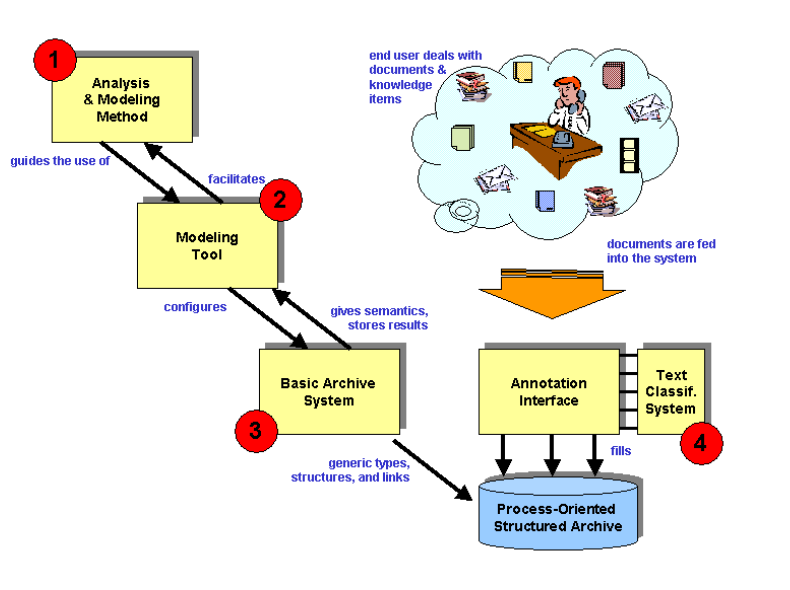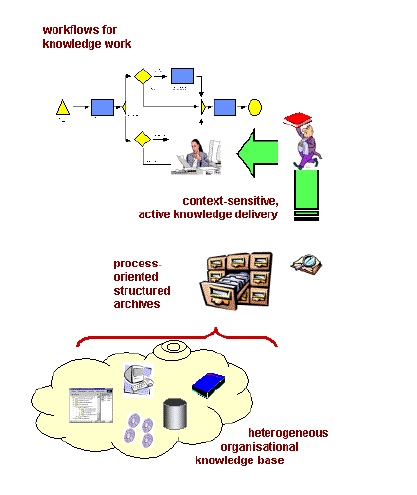July 2000–June 2002

#1. Project description
DECOR developed integrated methods and tools for active, context-sensitive and self-adaptive delivery of organizational knowledge at the business-processlevel. The results of the project comprised the realization of structured archiveswith domain ontologies and process models as key structures, process modellingand enactment tools, and a methodology to support organizational take-up.Development and validation has been performed in three test cases in the healthcare administration sector.
The project partners were
- DFKI
- ICCS
- PLANET ERNST & YOUNG
- SEMA Group Belgium
- IKA
- DHC
##Project’s Objectives,Approach & Solution Products
The fulfilment of thefollowing objectives lead to the respective DECOR products.
Objective 1: Enable storage, sharing, and reuse ofprocess-related explicit Knowledge.
The specific objective has been realised by building the DECOR Process-oriented Knowledge Archive, a software tool for creatingstructured archives of various (multimedia) knowledge and documents, organizedaround the notion of business processes performed in an organization.
###Objective 2: Ensure extensive, context-sensitive exploitation, and user friendly access to Knowledge Archive content.
Enabling proactive, context-sensitive knowledge supplyhas been realised by the DECOR Workflow-triggered Knowledge Delivery Toolkit. This tool realizes auser-friendly, easy-to-use and understand workflow enactment, including aworkflow-triggered activation method which automatically launches queries fromthe running workflow to the process-oriented knowledge archive described above.
###Objective 3: Support knowledge-oriented analysis oforganizations and processes.
The DECOR Business Process & KnowledgeModelling Toolkitgives methodological and technical supportfor integrated modeling and management of processes and knowledge. This comprises the elements:
- Representation means for modelling processes andprocess-embedded information needs, as well as ontologies and knowledge item descriptions.
- Modelling support for all these elements throughappropriate editors and tools.
- A method that guides and accompanies allmodelling activities, thus facilitating the organisational take-up.

Figure 1: Top-level view of the DECOR solution modules
Figure 1 gives a rough overview of the DECOR solution modules and their interrelationships.
The DECOR Business Knowledge Method is abusiness-process analysis, design, and modelling framework for integratedprocess and knowledge modelling. This methodological framework is supported bya modelling tool for graphically denoting the models of interest. The processmodels and domain ontologies created with these tools, instantiate the genericDECOR Basic Archive System to application-specific Process-Oriented StructuredArchives. For these archives, (weakly-structured, if necessary) Workflow Modelsplay the role of indexing structures organizing the knowledge contained.However, the workflow models can also be enacted by a Workflow Engine which,together with mechanisms for maintaining dynamic task context and task-specificarchive access, forms the DECOR Workflow-Triggered Knowledge-Delivery Toolkit.
The DECOR approach for Business Process Oriented KnowledgeManagement (BPOKM) presupposes a number things to be anaylsed and modelled: (1)Business process maps and domain ontologies for knowledge organisation andcontent description; (2) executable workflows for knowledge-intensive businessprocesses; and (3) information flow (through context variables) and informationneeds for workflow enrichment. These models must be acquired and maintainedover time. Further, the overall approach must be introduced in a company in thelarger context of a comprehensive Knowledge Management or Business ProcessManagement initiative. All required steps should be carried out by “normalconsultants” in a “normal organisation”, at reasonable costs, and with a predictableresult. Hence, DECOR introduced a structured approach for running Business ProcessOriented KM projects which supports all necessary project steps with appropriatemethodological guidance and modelling tools. Figure 2 gives a slightly moredetailed idea of the DECOR solution modules delivered to reach this goal.

Figure 2: DECOR modules used at system buildtime
The following constitute an overview of the DECOR solution modules for system modelling and maintenance time.
(1) DECOR Business Knowledge Method
DECOR’s Business Knowledge Method provides a methodological approach forrunning BPOKM projects. Its main elements include:
- Identification of knowledge-intensive processes
- Process analysis and knowledge-orientedre-design
- Domain ontology construction
- Analysis of task-specific knowledge needs
- The method combines elements from various sources, its procedural mskeleton can be seen as an amalgamation of CommonKADS and IDEF5.
(2)Business Knowledge Modeling Tool
The DECOR Modeling Tool supports in an integrated manner all modeling activitiesrelated to the method described above: business processes with task-specific informationneeds and process-specific context variables, as well as domain knowledgestructures and ontologies. In contrast to most existing ontology modelingtools, it primarily address users without a specific AI (Artificial Intelligence)background. It is oriented towards existing BPM tools (like ARIS™ or ADONIS™)and is realized as a set of related modeling methods for the commercialMicrosoft VISIO® 2000 visualization tool. This ensures a wide usability of thesoftware basis and a good familiarity of non-expert users with the overalllook-and-feel. The VISIO® interface actions are coupled by a dynamic link tothe DECOR Basic Archive System (see below). So, modeling activities at the userinterface directly lead to the respective effects in the configuration of the underlyingknowledge networks: new concepts or links are inserted in the ontologies, businessprocess models are extended, or indexing concepts added to document models.This dynamic link with the Basic Archive System allows to equip the graphicalmodeling interface with a semantic foundation: For instance, only reasonablelinks are possible, i.e., links which do not respect the value restrictions ofthe represented relationship can directly be rejected.
(3)Basic Archive System
The Basic Archive System stores knowledge items plus metadata, as wellas links between knowledge items. Metadata are represented in terms ofunderlying ontologies designed with DECOR modules (1) and (2). Business processmodels are one of many possible structuring criteria. Manual navigation inhierarchical indices extracted from index ontologies is allowed, as well asquerying the archive by XML retrieval messages which combine retrievalconstraints formulated over links and metadata. Software basis for the DECORBasic Archive System is the CognoVision® product offered by DHC GmbH. CognoVision®allows to represent arbitrary knowledge networks built from attributed objectsand attributed links, and to link information objects to structuring elements.Information objects encapsulate (i) logical content entitities like the set ofall documents with the same content, but in a different language, and (ii) therelated metadata.
(4)Annotation Interface
In order to fill the archive system, a software is needed for easilyattaching semantic categories (in terms of modeled ontologies) to knowledge items.In this way, documents are fed into the process-oriented structured archive andindexed with metadata. Since indexing is a well-known bottleneck forontology-based KM systems, in the run of the DECOR project a generic interfacein the form of an API (Application Programming Interface) has been builtbetween an annotation tool and an automatic text classification software, theMindAccess®tool provided by insiders information management GmbH. MindAccess® is anextensible multiple-paradigm tool which employs a number of state-of-the-art algorithms for text analysis and classification.

Figure 3: DECOR at runtime
The DECOR modules (1)-(4) refered to the design and installation of a process-orientedstructured archive and also to the process of filling it with annotatedknowledge items.The final two DECOR modules (described just below) are theruntime modules required for process execution:
(5) DECOR workflow tool
The DECOR Workflow Engine (DECOR WFE) executes the process models specifiedat build time. In DECOR special emphasis has been put on (i) the deep integrationwith the DHC’s commercial archive software, and (ii) on a comfortable systeminterface understandable and usable by “normal end users”.
(6) Context-aware knowledge agents
The purpose of the DECOR Context-aware Knowledge Agents is to co-operatewith workflow engine and modeled information needs, thus proactively offering informationfrom the process-oriented structured archive to the user in charge of a certaintask. It should be noted that the DECOR archive system offers not only possibilitiesfor retrieving knowledge items at process enactment time, but also for creatingdocuments and even folders, and for storing indexed knowledge items from therunning business process.
##Pilot systems
Concretely, the DECOR work was organised around thedevelopment of three pilot systems in the medical and social security sector:
One pilot was installed at IKA, the Greek SocialSecurity Institute. The system supports the process of granting full old agepension to insured people which – as part of a normal administrative workflow –contains some central, knowledge and document intensive steps for finding a decision. These steps must be legally checkable, they are often done with uncertainty,are influenced by many legal regulations and they are central for the correctresult of the process. The DECOR pilot aimed at ensuring a consistent, high quality of service for these decision steps.
One pilot was placed at the interface between CHU Brugmann, a most important Brussels hospital and CPAS, the body of each citythat has to deal with people who are in social, financial, … trouble. In theworkflow of accomplishing the patient file and sending administrative andaccounting data to CPAS there are often delays and wrong decisions made due to missinginformation, knowledge and experience (which is available in other steps of theprocess) which leads to heavy financial losses.
One pilot was built for the Plasmaverarbeitungsgesellschaft (PVG) in Springe, Germany. Thiscompany, a subsidiary of the German Red Cross, deals with the acquisition,transport, storage, and processing of blood and blood plasma donors. In this highly sensitive application area, all software systems employed, and in particularthe company’s SAP R/3 installation, must be validated according to national andinternational laws and regulations. The process of making changes to this SAPR/3 system while keeping the validation status is document andknowledge-intensive and was supported by the DECOR pilot system.
#2. Related publications
- Papavassiliou, G. and G.Mentzas (2003) Knowledge Modelling inWeakly-structured Business Processes, Journal of Knowledge Management, Vol 7,No. 2, pp. 18-33, July 2003.
- Papavassiliou G., S.Ntioudis, A. Abecker, G. Mentzas (2003) SupportingKnowledge Intensive Work In Public Administration Processes, Knowledge andProcess Management Journal, Volume 10, Issue 3, pp. 164 – 174, 2003.
- Papavassiliou, G., S.Ntioudis, G. Mentzas, A. Abecker Business (2003) ProcessModelling and Enactment for Task-Specific Information Support, WI-2003, 6thInternational Conference: Wirtschaftsinformatik 2003, Medien – Märkte- Mobilität, Dresden,17-19. September 2003.
- Abecker, A., G.Papavassiliou, G., S. Ntioudis, G.N. Mentzas, S. Müller (2003) Methodsand Tools for Business-Process Oriented Knowledge Management: Experiences fromThree Case Studies, ICE 2003 – 9th International Conference of ConcurrentEnterprising, Espoo, Finland, 16-18 June 2003.
- Papavassiliou G., S.Ntioudis, G. Mentzas and A. Abecker (2002) BusinessProcess Knowledge Modelling: Method and Tool, DEXA conference, TAKMA-2002, Third International Workshop on Theory and Applications of Knowledge Management, Aix-en-Provence, 2-6September 2002.
- Papavassiliou G., G.Mentzas and A. Abecker (2002) Integrating KnowledgeModelling in Business Process Management, ECIS2002 conference:The Xth EuropeanConference on Information Systems.
- Papavassiliou G., S.Ntioudis, G. Mentzas and A. Abecker (2002) ManagingKnowledge in Weakly-structured Administrative Processes, OKLC2002 conference:Third European Conference on Organizational Knowledge, Learning, andCapabilities.
- Andreas Abecker et al.(2001) DECOR – Delivery of Context-Sensitive Organizational Knowledge, eBusiness and eWork 2001 (EMMSEC 2001) Conference and Exhibition, Venice, Italy, 17-19 October 2001
- Andreas Abecker, Gregoris Mentzas, Maria Legal, Spyridon Ntioudis, Giorgos Papavassiliou (2001) Business-Process Oriented Delivery of Knowledge through Domain Ontologies, DEXA conference, TAKMA-2001, Second International Workshop on Theory and Applications of Knowledge Management, Munich, 3-7 September 2001.
- Andreas Abecker, AnsgarBernardi, Spyridon Ntioudis, Ludger van Elst, Rudi Herterich, Christian Houy, Maria Legal, Gregory Mentzas, Stephan Müller (2001) Workflow-Embedded Organizational Memory Access: The DECOR Project, JCAI’2001 Workshop on Knowledge Management and Organizational Memories,August 2001, Seattle, Washington, USA.
- Andreas Abecker, AnsgarBernardi, Spyridon Ntioudis, Rudi Herterich, Christian Houy, Maria Legal,Gregory Mentzas, Stephan Müller(2001) The DECOR Toolbox for Workflow-EmbeddedOrganizational Memory Access, ICEIS 2001, 3rd International Conference onEnterprise Information Systems, Setúbal, Portugal, July 7-10, 2001
- Abecker, A. and G. Mentzas(2001) Active Knowledge Delivery In Semi-Structured Administrative Processes, M. Wimmer (ed) Knowledge Management in ElectronicGovernment, KMGov-2001, pp. 47-57, 2nd International Workshop organized by IFIPWG 8.3 and 8.5, May 22 – 24, 2001, Siena, Italy
#4.Project website
http://www.dfki.uni-kl.de/decor/

